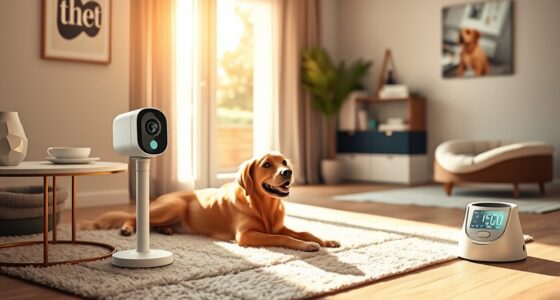To control your smart home with your voice, start by choosing the voice assistant that best fits your needs, like Google, Amazon, or Apple. Set up your smart speaker or display, connect your devices, and assign clear names. Create routines and customize commands for ease. Regularly test and optimize performance while managing privacy and security settings. Following these steps will help you gain seamless control—more tips await to make everything work perfectly.
Key Takeaways
- Choose a compatible voice assistant ecosystem (Google Assistant, Alexa, or HomeKit) and set up the corresponding smart speaker or display.
- Connect and name your smart devices clearly, using descriptive labels and grouping for easier voice control.
- Create custom voice commands and routines to automate multiple actions with simple phrases.
- Optimize device placement and use voice training features to improve recognition accuracy and responsiveness.
- Regularly update firmware, review privacy settings, and troubleshoot connectivity issues for secure, reliable operation.
Choosing the Right Voice Assistant for Your Home
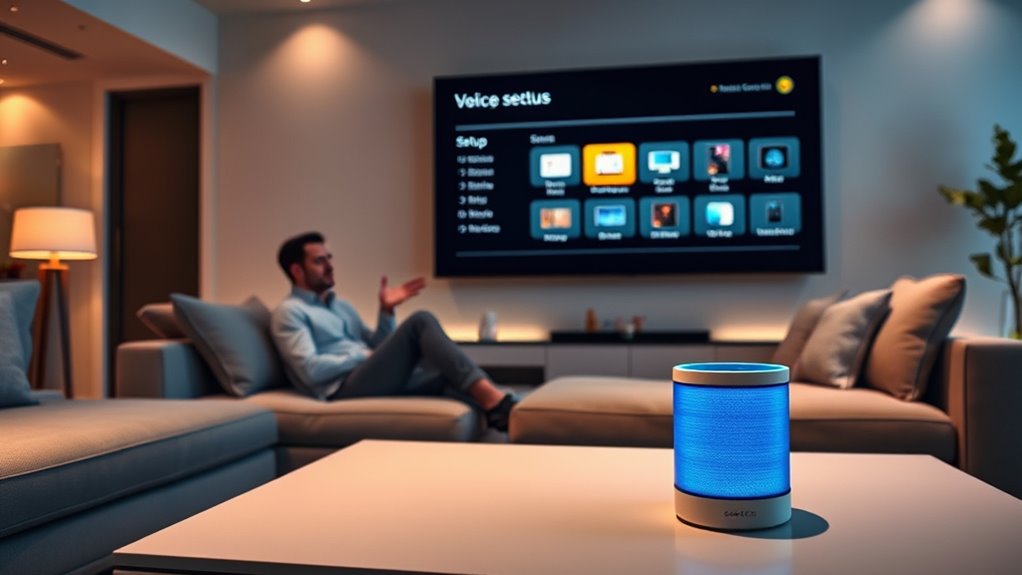
Choosing the right voice assistant depends on your priorities and existing devices. If you want seamless voice control and smart home devices that work together smoothly, consider the compatibility within each ecosystem. Ecosystem compatibility can significantly influence your overall experience and the ease of managing your smart home. Additionally, selecting an ecosystem that supports home automation integrations can make expanding or customizing your setup much more straightforward. Google Assistant offers advanced conversational abilities, making it great for Android users, and supports easy device setup through a smart speaker or display. Amazon Alexa supports the broadest range of smart home devices and third-party skills, giving you extensive options for home automation. Apple’s HomeKit prioritizes security and privacy, ideal if you’re an iPhone user, though it supports fewer devices. Look for support logos like “Works with Google Assistant,” “Works with Alexa,” or “Works with Apple HomeKit” to verify compatibility. Picking an ecosystem simplifies device setup and enhances your overall experience. Additionally, considering smart home security measures can help protect your connected devices and personal data. Establishing a secure network and regularly updating device firmware are key steps in enhancing your smart home security.
Setting Up Your Smart Speaker or Display
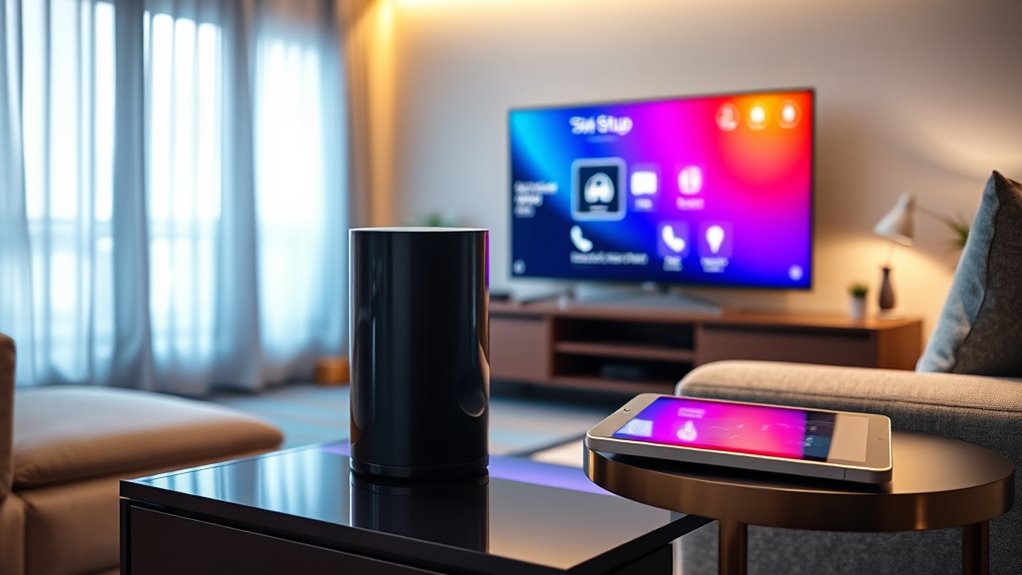
To set up your smart speaker or display, start by downloading and installing the relevant voice assistant app—Google Home, Alexa, or Apple Home—on your smartphone or tablet. Power on your device and follow the on-screen instructions to connect it to your Wi-Fi connection, making sure it’s a strong, stable signal. During the setup process, use the app to complete device registration, linking your account and giving your device a unique name like “Living Room Echo” for easy identification. If available, perform initial voice recognition training to improve accuracy in understanding your commands. Once setup is complete, test the device by issuing simple voice commands, such as “Hey Google, what time is it?” or “Alexa, play music,” to confirm everything is working correctly. Ensuring a stable Wi-Fi connection can significantly improve the responsiveness and performance of your smart home devices. Additionally, being aware of the Log In process and security features can help protect your device and personal information, ensuring a safer smart home experience. Regularly reviewing security settings can help prevent unauthorized access and safeguard your privacy. For optimal functionality, consider reviewing essential settings such as voice recognition preferences and privacy controls. Also, enabling necessary cookies can improve device performance and user experience during setup.
Connecting and Naming Your Smart Devices
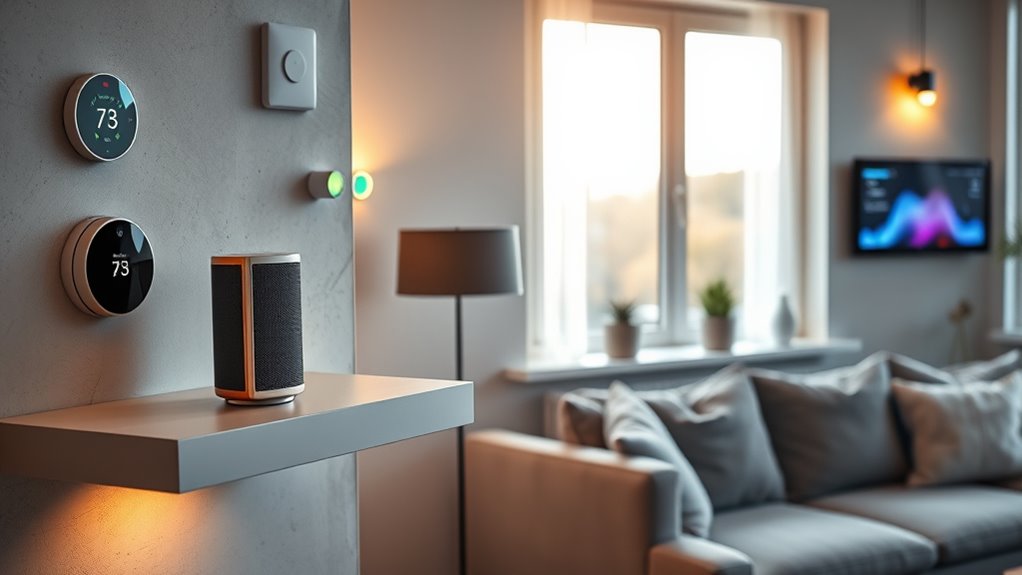
Once your smart device is set up and connected to Wi-Fi, the next step is to assign clear, descriptive names to each one. Use your app setup to rename devices, such as “Living Room Lamp” or “Front Door Lock,” ensuring accurate device recognition. Unique device names prevent confusion during voice control. You can also group devices, like “Kitchen Lights,” to simplify voice commands and automation routines. Make sure to verify that names are distinct and update them whenever you reorganize or add new devices. Proper naming enhances voice control efficiency and helps your smart devices respond accurately. Additionally, choosing diverse designs and materials can improve both the aesthetics and functionality of your devices, making your smart home more personalized and efficient. Understanding device recognition and how it impacts voice command accuracy can further optimize your setup. Employing consistent naming conventions can also streamline device management and improve overall system performance. For example, assigning logical and standardized names helps maintain system organization and reduces errors during operation. Regularly reviewing your device names and grouping strategies can also enhance your overall smart home experience.
Configuring Voice Commands and Routines

Creating custom routines allows you to automate multiple actions with a single phrase, making your smart home more efficient. Optimize your voice commands by using clear, specific names so your assistant responds accurately. Regularly update and test your routines to keep everything running smoothly and adapt to any changes. Always review your privacy settings to ensure your personal data and preferences are protected while managing your smart home. Be aware of cost considerations to ensure your setup remains within your budget and to avoid unexpected expenses. As cyber threats evolve, implementing AI security technologies can further safeguard your smart home devices from vulnerabilities. Additionally, understanding smart home device compatibility helps ensure all your devices work seamlessly together. Monitoring your electric heated mattress pads can help prevent potential safety issues and ensure they function correctly.
Custom Routine Creation
Custom routines let you personalize voice commands to control multiple smart home devices at once, making everyday tasks more seamless. With these routines, you can set specific triggers like “Good morning” or “I’m leaving” to activate device actions such as turning on lights, starting the coffee maker, arming security, or adjusting the thermostat. Most platforms, like Google Assistant, Alexa, and Siri, let you create routines through their apps, where you define triggers and automate actions. You can schedule routines to run automatically or activate them with a simple voice command. This setup enhances your smart home experience by consolidating complex commands into easy, memorable phrases. Additionally, many platforms support mobile responsiveness to ensure your routines work smoothly across devices, and understanding how to integrate voice commands with various devices can further optimize your setup. Incorporating smart home protocols can also improve compatibility and reliability of your routines.
Voice Command Optimization
Optimizing your voice commands guarantees your smart home responds accurately and efficiently. Start by clear device naming within your voice assistant app, ensuring each device is easily recognizable through specific commands.
Create routines and automation sequences that trigger multiple actions with a single voice command, like “Good morning,” which turns on lights, plays news, and adjusts the thermostat.
Use platform-specific commands such as “Turn off living room lights” or “Set thermostat to 72 degrees” to improve command clarity.
Take advantage of voice training features offered by assistants like Google and Alexa to enhance device recognition and pronunciation.
Regularly review and update your routines and device names to keep your smart home setup responsive as your configuration evolves, maintaining smooth and precise voice command optimization.
Integrating Multiple Devices and Ecosystems
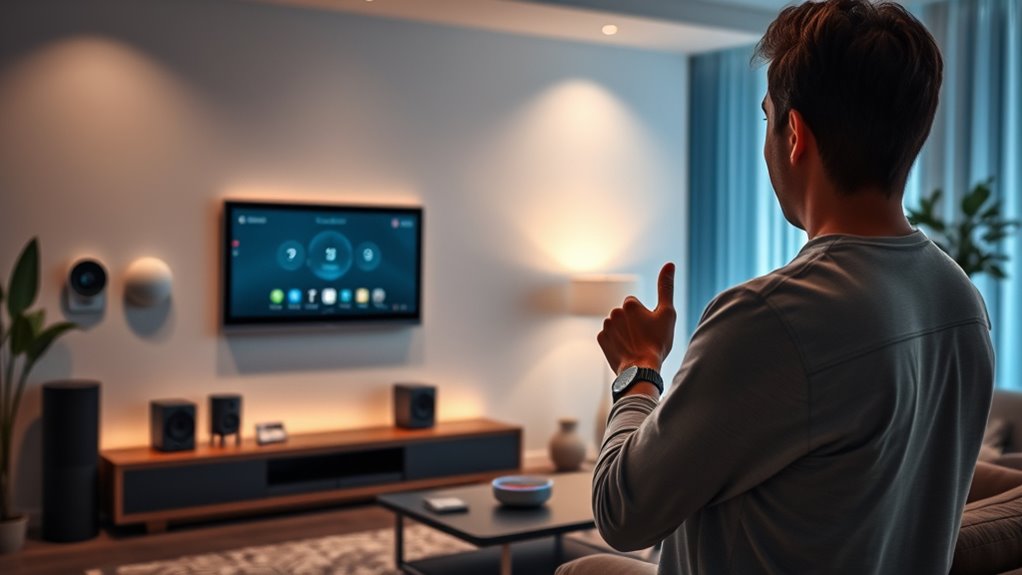
Integrating multiple smart devices across different ecosystems can seem complex, but using compatible standards like ZigBee, Z-Wave, Thread, or Matter simplifies the process. These smart device standards enable device integration and improve device interoperability across various smart home ecosystems.
Many platforms support cross-platform control through hubs and bridges, such as Samsung SmartThings or Apple HomePod, allowing you to manage multiple devices in a single app.
The emerging Matter protocol further unifies device communication, reducing the need for multiple hubs and streamlining setup.
Linking devices from different ecosystems often involves connecting them to a central platform or using automation services like IFTTT.
Proper device naming, grouping, and creating digital rooms enhance interoperability, making voice commands more effective and your smart home more cohesive.
Testing and Optimizing Voice Control Performance

Have you ever wondered why your voice commands sometimes miss the mark? It often comes down to voice recognition and device setup. To improve response accuracy, start by testing your device in a quiet environment, ensuring it correctly interprets different phrases.
Regular firmware updates and voice training can substantially enhance performance, so keep your device and app up to date. Proper device positioning is essential; place your smart speaker or display centrally with minimal background noise and a clear line-of-sight.
Customize device names and groupings to reduce confusion during commands. Use diagnostic tools or voice training features in your app to fine-tune recognition.
These steps help optimize your setup, making your voice-controlled smart home more responsive and reliable.
Managing Privacy and Security Settings
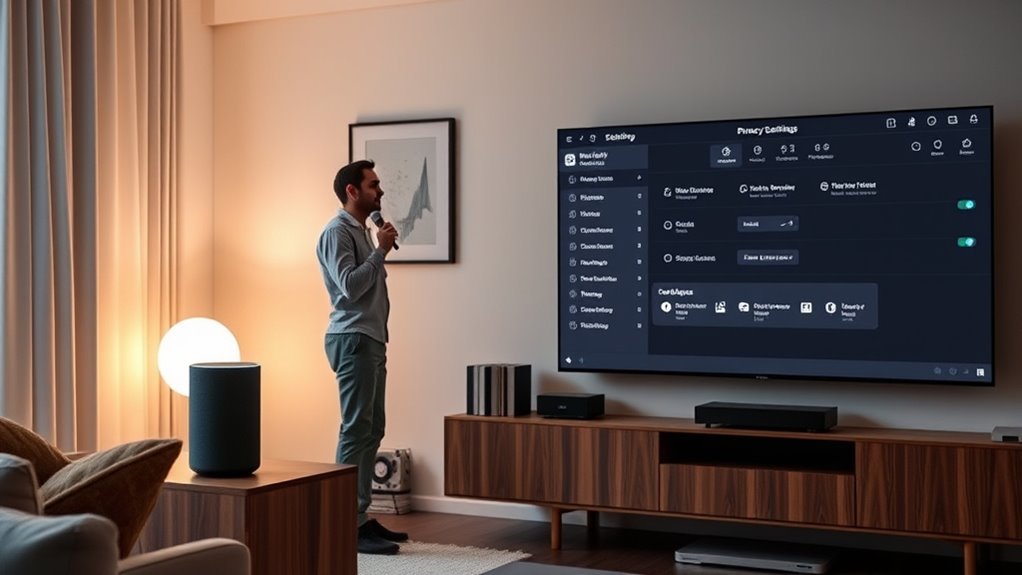
Once you’ve fine-tuned your voice recognition and device setup, it’s important to turn your attention to managing your privacy and security settings. Regularly review your privacy settings in the voice assistant app to control data sharing and personalized experiences.
Regularly review your voice assistant privacy settings to protect your data and personalize your smart home experience.
Delete voice recordings periodically through the app to maintain privacy and limit stored data. Enable multi-factor authentication (MFA) whenever available to prevent unauthorized account access.
Use local control options and disable cloud-based processing for sensitive functions, reducing data transmission and enhancing privacy. Keep your device firmware and app software up to date to apply security patches and fix vulnerabilities.
Monitoring and adjusting these settings ensures your smart home remains secure, your data stays protected, and your privacy is maintained as you enjoy voice-controlled convenience.
Troubleshooting Common Voice Control Issues
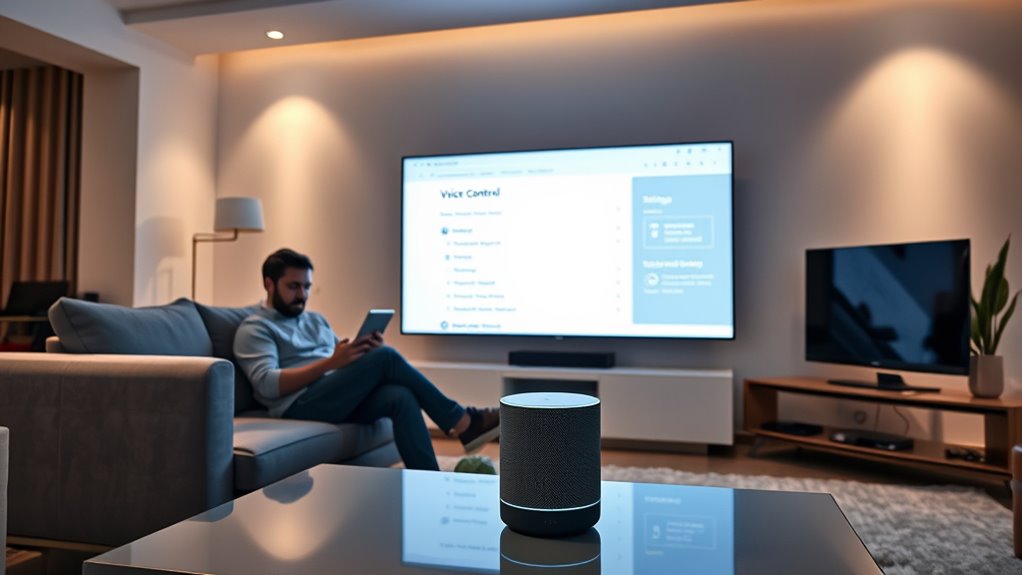
If your voice commands aren’t working as expected, start by checking if your device is connected to the right Wi-Fi network and that the microphone isn’t blocked.
Sometimes, simple issues like background noise or unclear speech can cause recognition problems, so speak clearly and make sure your device is updated.
If problems persist, restarting your devices and router can often fix connectivity or compatibility glitches.
Voice Recognition Challenges
Voice recognition can sometimes misfire or struggle to understand your commands, especially when there’s background noise, multiple people speaking, or the device isn’t positioned correctly. These environmental factors can lower voice command accuracy, making it harder for your device to pick up your voice. Microphone malfunctions or hardware issues also hinder proper recognition. Using ambiguous commands, such as vague phrases, can confuse your assistant further. To improve performance, ensure your device is well-placed and firmware is up to date. Consider reducing background noise and speaking clearly. Here’s a quick guide to common issues:
| Issue | Solution | Tip |
|---|---|---|
| Background noise | Minimize noise during commands | Use in quiet environments |
| Microphone malfunctions | Check hardware and firmware updates | Replace faulty hardware if needed |
| Ambiguous commands | Use clear, specific phrasing | Practice simple commands |
Connectivity and Compatibility Issues
Connectivity and compatibility issues are common obstacles that can prevent your smart home devices from responding reliably to voice commands. To fix this, make certain your Wi-Fi connection is stable, preferably on the 2.4 GHz band, which offers better device compatibility.
Check that your Wi-Fi router supports current standards like Wi-Fi 5, Wi-Fi 6, or Wi-Fi 6E to handle multiple devices smoothly. Updating your device firmware and voice assistant app can resolve software glitches.
Confirm that your smart device is properly linked within the voice assistant app, with correct device naming and grouping. Additionally, use diagnostic tools to identify Wi-Fi interference, and consider changing Wi-Fi channels or repositioning your router for improved network stability.
Proper smart device setup and linking are essential for seamless voice control.
Frequently Asked Questions
What Is Smart Home Voice Control?
Smart home voice control lets you operate your devices using just your voice. You can ask your virtual assistant—like Alexa, Google Assistant, or Siri—to turn on lights, adjust the thermostat, lock doors, or play music. It’s all about hands-free convenience.
To get started, you connect your compatible devices to Wi-Fi, name them clearly, and set your preferences in the assistant app. This makes managing your smart home simple and effortless.
How Do I Control Google Home With Voice?
Did you know that voice control is one of the most effective ways to manage your smart home?
To control Google Home with your voice, just say “Hey Google” or “OK Google,” then give your command, like “Turn on the kitchen lights.”
Make sure your device is connected to Wi-Fi, linked to your Google account, and set up in the Google Home app.
Practice a few commands to get comfortable with it.
Can You Use Voice Control With Home Assistant?
Yes, you can use voice control with Home Assistant. You’ll need to connect it to compatible voice assistants like Google Assistant, Alexa, or Siri. Set up the integrations and configure routines or scripts to execute commands.
For local voice recognition, options like Rhasspy or Mycroft are available. Just make certain your devices are properly connected, your network is configured correctly, and the integrations are enabled for seamless voice control.
What Devices of a Smart Home Can Be Controlled From?
You can control a variety of smart home devices from your voice, including lights, thermostats, door locks, security cameras, and outlets. These devices often support standards like Alexa, Google Assistant, or Apple HomeKit, making them compatible with your voice commands.
Devices with built-in microphones or those connected through hubs let you operate them remotely, giving you convenience and security at your fingertips.
Conclusion
Now that you’ve mastered the art of voice control, your smart home will practically run itself—just don’t be surprised if it starts giving you attitude or forgetting your favorite routines. Remember, with great power comes great responsibility (and occasional misheard commands). Keep an eye on those privacy settings, or next thing you know, your thermostat might decide it’s time to turn up the heat during a snowstorm. Happy voice-controlling!



